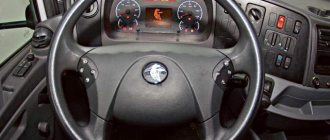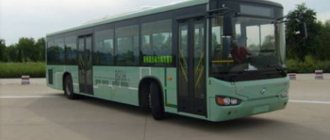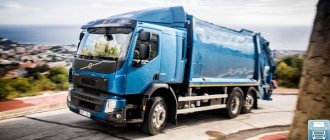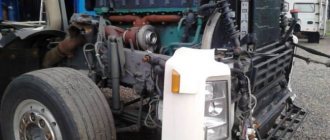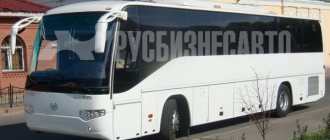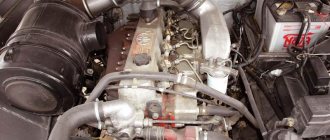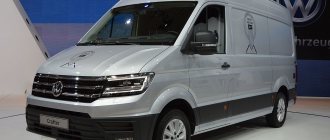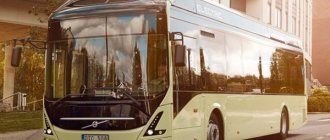| This article need additional quotes for verification . |
| Volvo B10M | |
| National Express Plaxton Premiere Building B10M at Manchester Airport in April 2003 | |
| Review | |
| Manufacturer | Volvo |
| Production | 1978–2003 |
| assembly | Sweden (1978-2001) United Kingdom (1990-2000) Brazil (1986-2003) |
| Body and chassis | |
| Class | Bus chassis |
| Body type | Single decker bus Single decker articulated bus Single decker intercity bus Double decker bus |
| Doors | 1, 2 or 3 |
| Floor type | Stepped entrance |
| Transmission | |
| Engine | 9.6L horizontally mid-mounted I-6 Volvo THD100, THD101, THD102, THD103, THD104, DH10A |
| Capacity | From 40 to 91 seated |
| Transmission of infection | Voith DIWA 381.4 Voith DIWA 863.3 ZF 4HP 500 ZF 5HP 500 ZF 5HP 560 |
| Dimensions | |
| Wheelbase | 4.60, 5.00, 5.50, 6.00, 6.25, 6.50, 7.00 meters |
| Length | varies |
| Height | varies |
| Chronology | |
| Predecessor | Volvo B58 |
| Successor | Volvo B12M |
In Volvo B10M
It is a mid-engine city bus and coach chassis produced by the Swedish automaker Volvo between 1978 and 2003. B58 and was powered by the same 9.6-litre horizontally mounted Volvo diesel engine mounted under the floor behind the front axle. An articulated version called the Volvo B10MA was also offered, as well as a semi-integral version known as the C10M, with the engine in the middle of the chassis.
Story
Stagecoach South Alexander PS bodied B10M at Horsham in September 2008 Preserved Gray Green Alexander Van with Citybus bodied in June 2003 Arriva Medway Towns Northern Counties Palatine bodied Volvo Citybus in school bus livery at Cliff in August 2009 An East Lancs City bus with coachwork owned by Hilton's Travel, Newton-le-Willows SBS Transit with Duple Metsec coachwork Volvo B10M to Singapore Veolia Transport Custom coach coach B10M MkIII to Sydney in July 2013 Pressed Metal Corporation South Australia body B10MA to Adelaide Stagecoach New Zealand motor bodies VöV body B10M
Designed as a successor to the Volvo B58, most of the B10M chassis was built in Sweden, but some were built in other countries, such as the UK.[1][2] and Brazil.[3][4]
The B10M was one of the best selling chassis in the UK throughout the 1980s and 1990s. Originally produced only as a touring chassis, the B10M was produced as a city bus, in which form it was also very popular.
It was available as B10M-46, B10M-50, B10M-55, B10M-60, B10M-62, B10M-65 and B10M-70, where the number denotes the wheelbase in decimetres. However, many coachbuilders shortened or widened the chassis to suit their needs. No later than 1981, a three-axle chassis was introduced, available as the B10M-50B, B10M-55B, B10M-60B, B10M-65B and B10M-70B, with some coachbuilders extending their wheelbase to 7.25 meters.
City bus (B10MD/D10M)
A double-decker version, the B10M, was developed for Strathclyde PTE in 1981. It was launched in early 1982 with a downsized engine compared to the coach, and was named Citybus (also known informally as the B10MD or D10M). The earliest examples were built by Alexander Coaches, who provided a modified version - common to all Volvo double-deck chassis produced by the company after 1980 - of its popular and attractive R body style. East Scots and Fife Scots bought many of these early versions in 1985-1987 gg. Two were exported in 1984, one to Singapore Bus Service and the other to Kowloon Bus, but were destroyed by fire in 1988. The Citybus lasted until the end of the B10M's production, but fell out of favor after Volvo redesigned it. Leyland Olympian as Volvo Olympian in 1993[5]
B9M
The B9M was released in 1982 as a lightweight, stripped-down budget version of the standard B10M. It was available as B9M-46, B9M-50, B9M-55 and B9M-60. Although not technically a successor to the B57, it found more or less the same place in the markets where it was available. The B9M had the same 9.6 liter engine as the B10M, but with less power. It sold well in the Scandinavian countries, with the exception of Denmark, where only a few were sold. The model has been available since at least 1996.
In the United Kingdom, the B9M-46 was sold as a shortened version of the B10M from 9.5 to 9.7 meters from 1985.[6]
B10MT and B10T
From 1984, a right-hand drive version of the B10M-55B was available as the B10MT, later also the B10T.[7]
C10M and B10M-C
In 1984, Swiss coachbuilder Ramseier & Jenzer collaborated with Volvo to introduce a semi-integrated bus known as the C10M, with the engine in the middle of the chassis. The C10M ceased production in 1987, but this engine was still available as an option and became known as the B10M-C.
Main article: Volvo C10M
Engine/powertrain characteristics
- Model. DB Volvo THD101/102.
- Type. Diesel.
- Number and arrangement of cylinders. 6, in-line.
- Environmental safety standards. Euro-2.
- Working volume, l. 9.6.
- Engine power, kW (hp)/min. 245 at 2050 min-1.
- Maximum torque, Nm/min. 1500 at 1020 min-1.
- Engine location. Posterior, middle.
- Checkpoint. 4-speed automatic, Allison MT647.
- Front-rear axle suspension. Independent on a subframe, spring struts, semi-independent, trailing arms.
- Control fuel consumption at 60 km/h, l/100 km. 46.
- Maximum speed, km/h. 90-105.
United Kingdom
Bus operators National Express, Hamilton Park, Haircuts and Wallace Arnold all purchased large quantities of B10M.[8]
In the 1990s, Stagecoach standardized on the B10M bus version, as their full-size single-decker. Most received Alexander PS bodies, but some received the Northern Counties Paladin body. Stagecoach also took many examples of the coach version from the Plaxton Interurban body and the Jonckheere Modulo body. South Yorkshire Transport and Kelvin Central Buses have also purchased larger type numbers with Alexander PS bodies.
The B10MA articulated variant had limited popularity among bus operators in the UK. British Caledonian Airways sold four examples in the UK after eight years, and four examples were delivered to Ulsterbus. Stagecoach was the largest buyer of this model in the UK, purchasing 18 in the mid-to-late 1990s, the last of which was delivered in 1999.
Specifications
- Fuel type. Diesel.
- Fuel tank capacity. 250.
- Curb and technically permissible weight, kg. 14900 and 18000.
- Load on front/rear axle based on technically permissible weight, kg. 7500 / 10500.
- Steering gear. With hydraulic booster.
- Steering type. Rack and pinion.
- Brake system. Pneumatic, ABS.
Singapore
Singapore Bus Services rated a mid-engined Volvo B10MD double-decker bus body East Lancashire Construction Companies registered as SBS4961B in 1984. However, no further two-deck B10MDs were purchased. The second B10M demonstrator, SBS9C, was an air-conditioned single-deck bus with a body. Van Hul and was acquired in 1986. It was the only Volvo B10M Mark I purchased by SBS and by the late 1990s it was sold to an operator in New Zealand.[9]
Singapore Bus Services (SBS Transit) acquired 977 units between 1988 and 2000, making up the majority of its single-decker bus fleet.
Volvo B10M Mark IIs were the first to be used, with 200 delivered between March 1988 and April 1989. They were withdrawn from production by May 2008 after reaching the end of their 19-year service life, with the exception of one which was sold to New Zealand. Mark II were replaced by Scania K230UB Euro 4 and Volvo B10BLE CNG.
Between November 1992 and June 1993, 300 B10M Mark IIIs were delivered. Duple Metsec, and has undergone a mid-life renovation. Most units were extended for two years due to insufficient numbers of replacement buses, and all were scrapped by June 2012.
Between June 1995 and December 2000, 475 B10M Mark IVs were delivered. Duple Metsec or Walter Alexander Strider. Midlife upgrades extended their service life by two years, and in 2017, 30 DM3500-bodied buses were extended by a further year due to insufficient numbers of replacement buses. All these buses have been written off as of December 23, 2022.
The 14.5 m B10M Superlong three-axle bus, built by Duple Metsec, was purchased in 1995 (UITP Congress 1995) and retired in October 2012.
A 19m B10MA articulated bus, also with a Duple Metsec body, was purchased in 1996. It was known as "Asia's Longest Bus". In 2006 it was sold to Bayes Coachlines in New Zealand.
United States
Several B10M aircraft were built and used from 1983 to 1986. United States. The American B10M was produced primarily in articulated form (purchased by SEPTA, SamTrans, and New Jersey Transit) although a standard length B10M model was made for RIPTA with one example sent to SEPTA as compensation for delays. Canadian production of the B10MA articulated bus under license from Ontario Bus Industries nearly happened, but fell through when that company struck a better deal with Ikarus Bus.
Belgium
At least 168[18] B10M and B10MA buses were purchased by Belgian operators (SNCV/NMVB, TEC and De Leijn). They were fitted with bodies from Belgian manufacturers: Van Hoole (A120[], Linea[]), Jonckheere (TransCity, 056, Transit[], Communo[], Transit 2000[]) and some had the Dutch Hainje/Berkhof ST2000[] , Berkhof 2000NL [] or Berkhof Excellence 500 body.
In Belgium, the majority of buses on the B10BMA chassis were owned by state-owned operators, while the B10B buses were owned by private lessees under contract to these operators.
Although most of these buses have now been discontinued in Belgium, De Lijn still owns some Jonckheere Transit 2000 G articulated buses.[18]
Australia[edit]
In Australia, the B10M has been purchased by state-owned operators Adelaide Metro, Brisbane Transport and Metro Tasmania, [11] [12] as well as private operators, with large fleets built in Sydney Busbar and Westbus, [13] [14] and in Melbourne by Grenda Corporation and Sita Buslines. [15] [16]
The B10Ms triaxle were equipped with high and double decker coach bodies with AAT Kings, Ansett Pioneer, Australia Pacific Tours, Greyhound and Westbus among the buyers.
Greece
Articulated B10M in Patras, Greece
An articulated version of the B10M designed by Sarachaki under the "Alexandros" brand in 1993, 1995 and 1997. All buses were ordered by the Thessaloniki Urban Transport Organization (ΟΑΣΘ) in Thessaloniki, Greece.
- The 1993 version featured steering on the rear axle.
- 1995 and 1997 are facelift versions and the chassis at the rear has been redesigned.
In Thessaloniki, 44 buses (1997 version) are still in use, but OASTH have equipped them with modern telematics GPS tracking systems. The older versions were redesigned and some buses were sold to Astiko Ktel Patron (Patras transport organization) and are still in use today (Q3 2015) in Patras, Greece. They operate routes connecting the outskirts of Patras with the city center and the city center with the University of Patras in Rion. In 2015, all Astiko Ktel Patron buses were equipped with GPS tracking systems for use with modern real-time bus arrival boards at bus stops and a mobile application.
Basic information, characteristics
- Manufacturer/manufacturer where the equipment is produced/manufactured. Volvo Bussar is a division of the Volvo Group and one of the world's leading manufacturers of bus chassis, which also develops, produces and sells complete high-capacity city and intercity buses under its own brand.
- Purpose. Urban, tourist.
- Class. Big.
- Body type. Single decker city bus. Single-decker articulated bus. Single-decker intercity/tourist bus. Double-decker bus.
Hong Kong
In Hong Kong, only 3 bus companies have purchased Volvo B10M for their fleet.
Citybus (CTB) has ordered 10 VanHool-bodied Volvo B10Ms with THD101GD engines installed between 1990 and 1992 for its border services between Hong Kong and mainland China. In 1997, CTB ordered 2 more Volvo B10Ms with a Chinese Volvo bus and DH10A engine fitted to their border fleet. Following the closure of border crossings, these B10Ms were sold to private tour bus companies in Hong Kong. All used CTB B10Ms were sold in 2009.
In 1995, KCRC ordered 15 Volvo B10Ms to replace its used fleet of MCW Metrobuses with Nordic bodywork, ZF4HP500 gearbox and Volvo THD102KF engine. These buses are also equipped with Lazzerini seats inside the cabin. All ex-KCRC B10Ms were sold to MTR due to the merger of Hong Kong's mass rail services in late 2007, MTR was repainted in the new fleet color in 2008. All B10M KCRC (MTR) were scrapped in 2012 due to incoming ADL Enviro500 Fleet 11.3 million
In 1994, Stagecoach in Hong Kong ordered 5 B10Ms with an Alexander PS body and a THD101GC engine installed. These B10Ms were serviced in private residential buildings in Hong Kong owned by Stagecoach. But Stagecoach Hong Kong folded in 1996 and these Volvo B10Ms were subsequently sold to New Zealand.
Recommendations
- Volvo B10M at Workington Commercial Motor
13 July 1989 - The British B10M debuts as a commercial motor
on 28 June 1990. - History – Anos 80 Grupo Volvo no Brasil
- Evolução do Produto — Ônibus Archived December 4, 2014 Wayback Machine Volvo Buses Brazil
- Volvo Power for an Olympian Commercial Motor
February 27, 1992 - Midi Volvo for sale Commercial motor
August 24, 1985 - "Volvo". tmv.thb.gov.tw. Archived from the original on December 5, 2014.
- Haircuts Pile Up Commercial Motor
December 13, 1990 - Davis, Mike; Phillips, Ron (2006). Singapore Buses, Volume 1 Singapore Bus Services, Part 2
. Published by DTS. ISBN 9781900515269. - "Tsukuba Expo Volvos in Australia" Australian Bus Review
Issue 6/1 July 1990 pp. 3-8 - Bus fleet listings Brisbane Transport Buses
- Metro Tasmania Australian Bus Fleet Listings
- Buses Australian Bus Fleet Lists
- CDC Group NSW Australian Bus Fleet Lists
- Ventura Group Australian Bus Fleet Listings
- Sita Bus Lines Australian Bus Fleet Lists
- Volvo B10M buses New Zealand Omnibus Society
- ^ a b
«|
Zoekresultaten | Zone 01." www.zone01.be
. Retrieved December 7, 2022.
Chassis characteristics
Bus Volvo B10M. Photo Wikipedia
Brand. Volvo B10M.
Wheel formula. 4x2.
Tires. 315/80 R22.5.
Anti-lock braking system (ABS). Present.
additional characteristics
Ventilation. Present.
Heating system. Present.
Luggage compartment location. In the lower part, under the floor of the passenger compartment.
